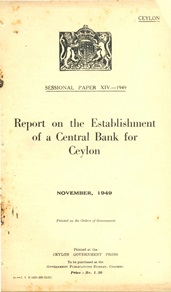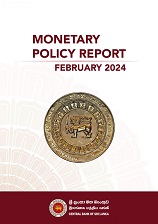About Monetary Policy
Overview
Monetary policy is the process by which a Central Bank manages the supply and the cost of money in an economy mainly with a view to achieving the macroeconomic objective of price stability.
Central Bank of Sri Lanka is responsible for conducting monetary policy in Sri Lanka, which mainly involves setting the policy interest rates and managing the liquidity in the economy. The monetary operations of the Central Bank influence interest rate in the economy, affecting the behavior of borrowers and lenders, economic activity and ultimately the rate of inflation. Therefore, the Central Bank uses monetary policy to control inflation and keep it within a desired path.
Price Stability
Price stability is a situation where there are no wide fluctuations in the general price level in the economy, which helps to achieve sustainable economic growth. When the prices fluctuate at a low rate, they would not have any significant influence on the economic decisions of agents of the economy, viz. households and firms. Moreover, price stability helps better anchor inflation expectations among the public, which in turn makes it easier to keep actual inflation at low and stable levels. Therefore, stable prices would not distort the economic decisions regarding what to produce and how to produce, thus enabling efficient allocation of resources in the economy leading to economic stability and sustainable growth in the economy over the longer term. Accordingly, as per the Central Bank of Sri Lanka Act, No.16 of 2023 (CBA), the Central Bank, in pursuing its primary objective of achieving and maintaining domestic price stability, shall also take into account, inter alia, the stabilisation of output towards its potential level.
Monetary Policy Framework
The Central Bank conducts monetary policy to achieve its primary objective of maintaining domestic price stability. According to the CBA, the Monetary Policy Board is responsible for formulating monetary policy and implementing a flexible exchange rate regime in line with the Flexible Inflation Targeting (FIT) framework. The FIT framework aims to maintain inflation at targeted levels as determined by the Monetary Policy Framework Agreement (MPFA) between the Minister of Finance and the Central Bank. The current MPFA, published in the Government Gazette on 5 October 2023, mandates the Central Bank to maintain quarterly headline inflation at 5 per cent.
To achieve the inflation target, the Central Bank uses its policy instruments to guide short term interest rates along the desired path. The Overnight Policy Rate (OPR), which is the primary monetary policy instrument that signals the Central Bank’s monetary policy stance, is periodically reviewed and adjusted appropriately, if necessary, to guide short-term interest rates in the money market. The Average Weighted Call Money Rate (AWCMR), which is a short-term money market interest rate, functions as the operating target under the current monetary policy framework. Further, Open Market Operations (OMOs) are also conducted to manage liquidity conditions in the domestic money market to steer short-term interest rates toward desired levels. Standing Facilities are available for those participating financial institutions that were unable to obtain their liquidity requirements at the daily auction.
Prior to the introduction of OPR, the rates of the Standing Facilities, i.e., the Standing Deposit Facility Rate (SDFR) and the Standing Lending Facility Rate (SLFR), served as policy interest rates of the Central Bank. Previously, the Central Bank conducted monetary policy within an enhanced monetary policy framework with features of both monetary targeting and flexible inflation targeting (FIT). Under this framework, the Central Bank attempted to stabilise inflation at mid single digit levels. Similar to the current practice, AWCMR was used as the operating target. During early 1980s, the Central Bank adopted monetary targeting as its monetary policy framework, and monetary aggregates were the key nominal anchors in the conduct of monetary policy. Under a monetary targeting framework, the changes in money supply are considered the primary causal factors affecting price stability. However, given the rising volatility in the money multiplier and velocity amid a weakening relationship between money supply and inflation, the role of monetary targets as a nominal anchor became uncertain and also complicated the Central Bank’s communication strategy, causing the Central Bank to upgrade its monetary policy framework.










